Cultural Backdrop: Classicism and the Hierarchy of Subject Matter
The idea that subject matter could per se determine the worth of a painting is profoundly alien to today's concept of art. And yet a strict hierarchy of subject matter in painting, formulated in sixteenth-century Italy, and later promoted by European academies, held sway with little revision until the early 19th century. The fact that the minor events of life, like those depicted by Vermeer, might be vehicles for great art had not yet been theoretically established. The hierarchy of Classicist hierarchy of subject matter:
- History painting (istoria) - encompassing grand historical, mythological, or religious narratives
- Portrait painting
- Genre painting or scenes of everyday life (of sufficient decorum)
- Landscape and cityscape
- Animal painting
- Still life
Popularity of Painting Types in Seventeenth-Century Dutch Collections
The chapter "Subjects Represented in Works of Art" in Art in History/History in Art: Studies in Seventeenth-Century Dutch Cultureprovides insights into the trends of different types of paintings during the mid-17th century, focusing on private collections in Amsterdam and Delft. Here is a breakdown of the types of paintings and their relative popularity:John Michael Montias, "Subjects Represented in Works of Art," in Art in History/History in Art: Studies in Seventeenth-Century Dutch Culture, ed. David Freedberg and Jan de Vries (Los Angeles: Getty Center, 1991), 334–-337.
-
Landscapes:
Landscapes were the most popular type of painting, representing about 28% in the Amsterdam probate inventories and 31% in Delft. They were relatively inexpensive and produced for the mass market, and rarely commissioned, contributing to their widespread availability and popularity.
-
Portraits:
Portraits ranked second in popularity, accounting for 16.5% in Delft and about 13-18% in Amsterdam. They were more expensive than landscapes and were often commissioned by private clients, focusing on capturing resemblance and personal attributes.
-
Genre Paintings:
Genre paintings, which depict scenes of everyday life, were highly favored in Amsterdam (more than 9% of total inventories) but were less prominent in Delft (under 6%). They were more affordable compared to portraits but more expensive than landscapes.
-
Still Lifes:
Still life paintings occupied about 13% of collections in Delft, whereas they represented around 6% in Amsterdam. These paintings often featured domestic items, fruits, or flowers, reflecting a more specialized taste.
-
Religious Paintings:
Religious paintings were relatively popular in Delft, comprising about 25.9% of collections, whereas in Amsterdam they represented only about 12.6%. The difference suggests regional variations in artistic preferences linked to cultural and religious influences.
-
Mythological and Allegorical Paintings:
These paintings were among the most valuable, often more than twice as expensive as landscapes or still lifes. Despite their value, they were less common in private collections compared to other popular subjects like landscapes and genre scenes.
Overall, landscapes, genre paintings, and still lifes were the most common types of paintings in private collections, representing between 58% and 69% of the total artworks. Their popularity was largely due to their affordability and availability, as they were often produced for the wider market without the need for specific commissions.
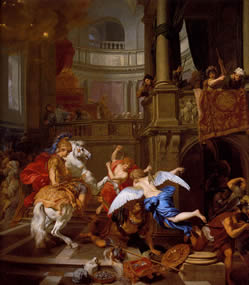
Gérard de Lairesse
1674
Oil on canvas, 204 x 193 cm.
Private collection
This hierarchy of subject matter, which seems to have relative effect on art collectors preferences, was based on a conceptual distinction between art that was produced by an intellectual effort to "render visible the universal essence of things" (imitare in Italian) and that which merely consisted of "mechanical copying of particular appearances" (ritrarre).In Italian, "imitare" and "ritrarre" carry distinct connotations, particularly within the context of art and representation. "Imitare" refers to the act of imitating or emulating something, often implying an effort to replicate or reproduce the essence, style, or characteristics of a subject or model. This term is associated with a broader, sometimes idealized approach to representation, aligning with theoretical frameworks that encourage artists to aspire to an elevated or perfected imitation of nature or artistic precedents. Conversely, "ritrarre" specifically means to depict, portray, or render a subject, often with a focus on faithful, detailed reproduction of the subject’s appearance or attributes. While "imitare" may involve an interpretative or transformative engagement with a subject, "ritrarre" suggests a more direct, observational relationship, emphasizing precision and the realistic capturing of the subject's physical or emotional essence. These differences underline a philosophical tension in art between idealization and faithful representation.
The Dutch art theorist and contemporary of Vermeer, Gérard de Lairesse (Groot schilderboek [Great Book on Painting], 1707), firmly believed that only subjects possessing inherent beauty (schoonheid) and virtue (deugd) were worthy of representation for they alone allow the painter to create the kind of "antique" beauty he regarded as essential to good painting.Claus Kemmer, "In search of classical form: Gérard de Lairesse's Groot schilderboek and seventeenth-century Dutch genre-painting," Simiolus: Netherlands Quarterly for the History of Art 26 (1998): 90. De Lairesse was a disciplined intellectual who was inspired by the notion that only correct theory could produce good art. For him theory meant the strict adherence to rules. The ultimate purpose of the visual arts was the improvement of mankind, and therefore art must, above all, be lofty and edifying.
The appropriate subjects that de Lairesse and all history painters had in mind were not those extracted from the artist's imagination or personal circumstances, but from texts: the Bible and Classical literature and mythology. Allegories and scenes of great historical events of the past and near-contemporary were also acceptable if painted in a classical mode.Claus Kemmer, "In Search of Classical Form: Gérard de Lairesse's 'Groot Schilderboek' and Seventeenth-Century Dutch Genre Painting," Simiolus: Netherlands Quarterly for the History of Art 26, no. 1/2 (1998): 87. Stories of street peddlers, cuckolded husbands, kitchen maids, unruly country bumpkins and buxom courtesans, from which a veritable army of enterprising Dutch painters made a passable living, would not do.
Not only was the subject matter important, but also the proper and improper modes of pictorial representation, as prescribed by academic standards. When painting in the "antique" mode, the artist should refrain from excessive characterization of the figures, definition of textures, indulgence in detail and the use of color as an end unto itself. Drapery should be painted with vigor and suppleness but it was better not to define specific fabrics with any precision.
Physiognomic types, noblemen, farmers or beggars, should be immediately distinguishable but no figure should be identifiable as an individual person. All pictorial effects should be subordinated to the composition as a whole, which was not so much a matter of aesthetics as of narrative.
Classicist theory, however, was not blindly adhered to in the Netherlands even by those who promoted it most strenuously. Karl van Mander (1548–1606),Karel van Mander's Schilder-boeck ("The Book of Painters") was first published in 1604 in Haarlem, the Netherlands. This seminal work is a mix of an artist's manual and a biographical encyclopedia of Netherlandish, German, and Italian painters. It had a significant influence on the understanding and documentation of the lives and works of artists in the early modern period. an early Dutch art writer who exhorted painters to depict "memorable histories," painted some peasant scenes. Samuel van Hoogstraten (1627–1678), another Dutch theorist and painter, paintedboth genre and trompe l'œil works, the latter of which has more to do with pictorial sorcery than the search for uplifting content, even though he was awarded a medal by the Holy Roman Emperor for his efforts.Samuel van Hoogstraten, Inleyding tot de hooge schoole der schilderkonst: anders de zichtbaere werelt (Rotterdam, 1678). Cesar van Everdingen, (1616/17–1678), often referred to as one of the Haarlem Classicists or Haarlem Academics, frequently depicted courtesans playing musical instruments or combing their hair (fig. 1).
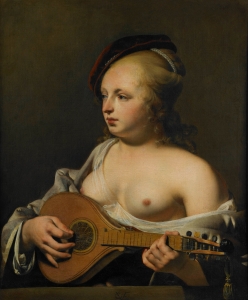
Caesar van Everdingen
1617
Oil on canvas, 78 x 63.3 cm.
Musée des Beaux Arts, Rouen
De Lairesse, who opposed joint artistic efforts, is known to have employed Johannes Glauber to fill in landscape background in some of his works. Moreover, de Lairesse, like many figurative Dutch painters, was unable to repress his Dutch colleagues' quintessential fascination for the depictions of specific textures and especially fine satins, practically a hallmark of Dutch painting.
"During a journey through the Netherlands in I781, Sir Joshua Reynolds paid a visit to the art collection of a certain Mr Gart in Amsterdam, owner, among others, of Gerrit ter Borch's Duet. In his journal, he compared this picture with de Lairesse's Death of Cleopatra (fig. 2) which he had recently seen in the Hope Collection, also in Amsterdam:
'Two fine pictures of Terburgh; the white sattin remarkably well painted. He seldom ommited to introduce a piece of white sattin in his pictures. As I reprobated the white sattin in the picture of the death of Cleopatre by Lairesse, and make no objection here, it must be remembered that the subject of Lairesse's picture is heroick, and he has treated it in the true historical style, in every respect, except in his white sattin: but in such pictures as Terburgh painted, the individuality and naturelness of the representation makes a considerable part of the merit."
Reynolds's remarks must be understood in the context of his general theory of art, and the issues he addresses as part of his notion of 'grand style.' Heroic subject matter demanded a heroic style, and the naturalism of the drapery in de Lairesse's work was as inappropriate as idealized figures would have been in genre painting. In this case, the Englishman's criticism was directed not at the genre painter ter Borch but rather at the history painter de Lairesse, who had broken the rules of high art with his excess of naturalness.'"Reynolds argued: "Strictly speaking, indeed, no subject can be of universal, hardly can it be of general, concern; but there are events and characters so popularly known . . . that they may be considered as sufficiently general for our purposes. Such are the great events of Greek and Roman fable and history, which early education, and the usual course of reading, have made familiar and interesting to all Europe, without being degraded by the vulgarism of ordinary life in any country. Such too are the capital subjects of scripture history, which, beside their general notoriety, become venerable by their connection with our religion." Joshua Reynolds, The Discourses of Sir Joshua Reynolds, P.R.A. (London: Printed for the Royal Academy of Arts; Macmillan and Co. Ltd., 1924).
Gérard de Lairesse
1686
Oil on canvas, 74.9 x 95.3 cm
Art Gallery of Ontario
From a technical point of view, history painting was considered by its proponents as the most intellectually demanding of all the categories, since the complex arrangements of multiple human figures required the artist's secure grasp of technique, composition and of history itself. On the other hand, genre painting, in which real-life, rather than text-based situations are represented, was too limited in scope to make truly universal art. In the words of de Lairesse:
I say then, that although modern [contemporary] things seem to have some prettiness, … they are only to be esteemed as diversions of art…I moreover maintain, that such painters as never produce more than one choice of subject, may truly be ranked among tradesmen; since such representations cannot be called an exercise of the mind, but a handicraft trade.
Specialization was not in itself condemned by de Lairesse as long as it was born from the artist's sincere inclination. However, the formulaic repetition of successful subjects or motifs was not.

Gérard de Lairesse
between 1676 and 1682
Oil on canvas, 125 x 94 cm.
Rijksmuseum, Amsterdam
According to de Lairesse, the hierarchy of different categories of paintings was determined by two factors, the subject matter and the manner in which it was depicted (imitatio) which he broke down to "worse than nature," "as in nature" and "better than nature." The concepts of gentility, grace and decorum were fundamental in true painting, as de Lairesse put it, "if [they] are missing from a picture we cannot approve of it." The figures should be purged of anything incidental as well as the mundane details in both dress and physiognomy. Even the postures of the poor and destitute had to be modified to meet acceptable standards of grace.
The peasant brawls of Van Ostade or Adriaan Brouwer (fig. 3) were condemned out of hand both for their coarse subject matter and for the "worse than nature" manner in which they were depicted while the quiet, middle-class assemblies of Van Mieris or Vermeer would have been considered depicted "as in nature," and, therefore, lacking the nobility of the "antique." Nonetheless, de Lairesse judged the burgerlijke(burger-like) subject matter far more acceptable than the "beggars, brothels, taverns, smokers, gamblers, filthy children on the potty-chair, and even dirtier and more horrible things," but still inferior to the Classical subject matter. Nonetheless, as no other people, the Dutch in the seventeenth-century embraced genre painting as an essential component o f their cultural lives.Elizabeth Alice Honig, "The Space of Gender in Seventeenth-Century Dutch Painting" in Looking at Seventeenth-Century Dutch Art: Realism Reconsidered (Cambridge, Cambridge University Press, 1997), 193.
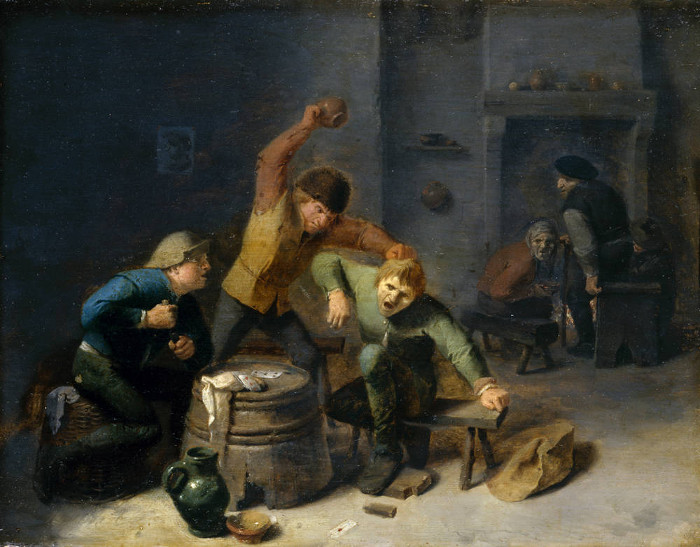
Adriaen Brouwer
1606 and 1638
Oil on oak, 26.5 x 34.5 cm.
Old Masters Picture Gallery, Dresden
Nonetheless, in respects to his contemporary Classicists in other parts of Europe, de Lairesse refuses to dismiss all forms of genre painting a priori. Differently from other writers on Classical painting, de Lairesse dedicated an entire chapter "Aanwyzinge om het burgerlyke of cierlyke modern wel uit te beelden" ("Method for correctly representing what is city-like or elegant modern") in his Groot Schilderboek. His aim was to demonstrate to painters of burgerlyke subjects like Gerrit ter Borch, Frans van Mieris, Vermeer and Gabriel Metsu, how classical forms can be adapted to high-life genre painting.
Vermeer and de Lairesse
Confronted by the formidable amount of paintings in the Netherlands of exceptional facture (and popularity) whose subject matter had nothing to do with his lofty ideals, de Lairesse felt that some sort of allowance must be made for the de facto plethora of tastes and did not reject all of them categorically: "As the genius of artists differs greatly; one leading to the sublime, another to the common, even to the meanest; so we find ourselves obliged to treat of all parts of the art, in order to be useful to every one," for it is … more commendable to be like a good Mieris [Frans van Mieris, Vermeer's contemporary] in the modern manner (fig. 4), than a bad Raphael in the antique."
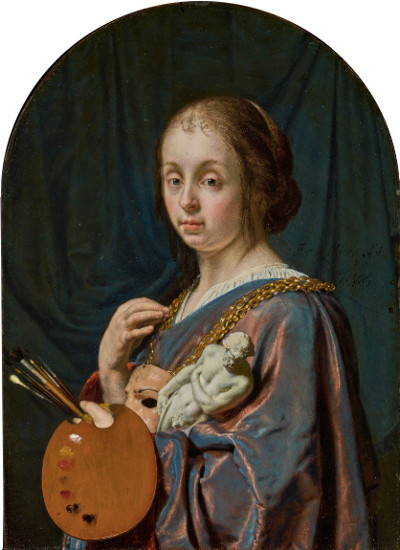
Frans van Mieris the Elder
1661
Oil on copper, 12.7 x 8.9 cm.
Getty Collection, Los Angeles
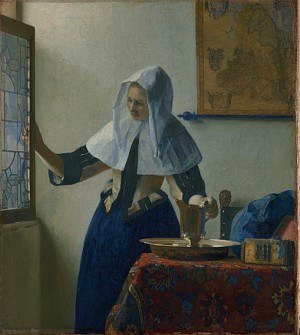
Johannes Vermeer
c. 1662–1665
Oil on canvas, 45.7 x 40.6 cm.
Metropolitan Museum of Art, New York
This work is one of Vermeer's most finely balanced works, cleansed of all anecdote and distracting detail. This and other pictures of the 1660s are frequently described by art historians as "classical" in design and proportion.
From a twenty-first-century vantage point, the mature works of Vermeer might be taken as a plausible response to de Lairesse's call for a reformed burgerlyke painting, "cleansed of all imperfections and improved." Indeed, the number of twentieth-century writers who have trumpeted Vermeer's measured brand of illusionism and social chronicle as "Classical," "idealized" or, at the very least, "perfectly balanced," cannot be counted. Critics point out that Vermeer always shunned the anecdotal, the picayune and the vulgar (except for the brothel scene of the early Procuress), and in this aspect at least, he stood apart from his genre colleagues. And most all knowledgeable art historians maintain that he aspired to "greater things" than they although it is not exactly clear to which lofty aims he aspired. However, today, the question of decorum and taste is no longer problematic for the art lover as it was for de Lairesse. Style and aesthetics of the past are considered equally legitimate, worthy of serious study and appreciable on their own terms.
Although Vermeer's art may appear to respond quite well to some of the de Lairesse's ideas of what constitutes "improved" burgerlyke motifs, it is impossible to know if Vermeer intended his art as a deliberate bridge from genre to Classicist concerns as expounded by de Lairesse (fig. 5). The artist's elegant, essential and muted style may have been nothing more than fruit of a deep-rooted personal inclination and/or a natural participation in the general refinement genre painting the 1660s and 1670s cultivated especially in Delft where the artist lived and worked. Perhaps, our concepts of artistic perfection and Classicism are much wider than what de Lairesse had in mind.
As de Lairesse wrote, "The modern painting can, therefore, not be accounted art, when nature is simply followed; which is a mere imperfect imitation or defective aping her. Even when a thing represented ever so natural, well-designed, and properly ordered; the condition manners, and custom of the country well observed, and the colouring most exact, yet knowing will not think it artful.; but when nature is corrected and improved by a judicious master, and the aforesaid qualities joined to it, the painting must be noble and perfect." In de Lairesse's statement one can easily see grounds for both condemnation and praise of Vermeer's best canvases.
Slavish Imitation and Coloring
According to de Lairesse's understanding of true painting, nature should not be "slavishly imitated" but consulted and subsequently idealized. The works of the great painters of the past should be admired and emulated, but not to the point of stifling one's own intellect and creative impulse. De Lairesse felt that there are "no greater abuse committed than in the use of line prints, and compositions of greater masters; for many accustom themselves so much to them, as seldom to do any thing which is not borrowed from prints, or other men's drawings."
Perhaps too often criticized for his conservative rhetoric, de Lairesse was surprisingly modern in his approach to coloring: "If Titian and Giorgione had good colouring, let us follow their way of doing things; they took Nature for their teacher, and did not imitate other masters; and although in all other respects Nature is deficient with respect to art, she is not in so far as concerns Colouring; thus is it that, in this branch of art, no better model has been found than the life itself."
In any case, classicist warnings seemed to have had not even the slightest effect on the habits of Dutch art collectors who spent their hard-earned money according to their personal taste, and at times, with an eye on investment returns. Paintings of every subject, dimension and style imaginable were consumed in enormous numbers overshadowing in production and variety those of any country in Europe. Foreigners were often astounded by the sheer number of pictures they encountered in the Netherlands. The fierceness of the competitive market spawned stylistic evolution, new subject matter and affordability. It was common that a house might have dozens of paintings. "Name buying" was already being deprecated. Curiously, the choice of subject matter did not seem to matter among collectors of different economic strata. While Classical theory determined the direction of painting in many countries in Europe, in the Netherlands, it was little more than a hand in front of a bursting dike.